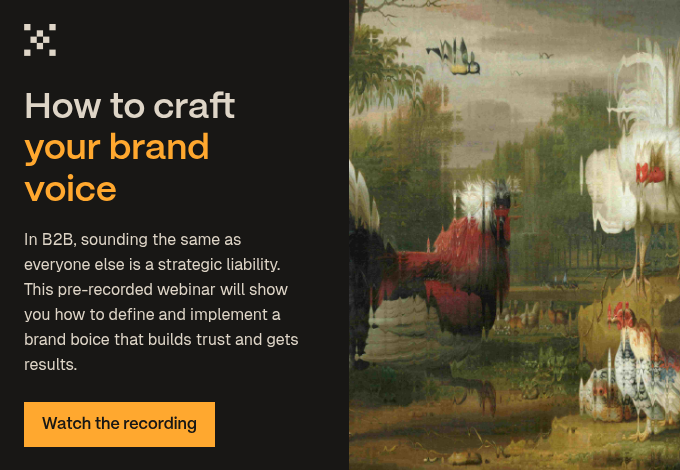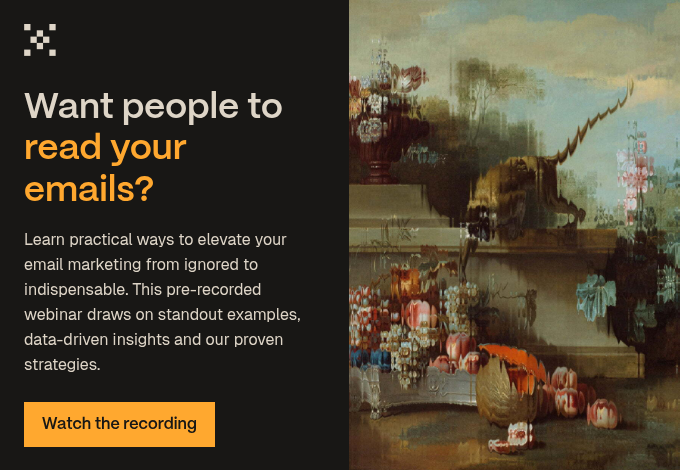Buying behaviour trends have changed dramatically in recent years. Many more people are buying online as a proportion of their budget and yet those same people have less money to spend overall. Both individual consumers and businesses are being extra careful with their budgets. So, their business is harder to win. Sales teams need to look beyond their usual tactics and adapt if they want to meet targets.
Today, we’ll look at the six key differences between how businesses buy and how consumers buy. Then, we’ll consider two models of buying behaviour and offer tips from our own sales process.
Why not see what you can learn from the other side of the aisle?
This blog is based on one of our popular webinars, this one hosted by our in-house Specialist Business Development Representative, James Dhakal. Watch the video and download the slides.
Key differences between B2B and B2C
Let’s get our definitions out of the way. In broad terms, the difference between B2B and B2C is:
B2B: In the business-to-business market, businesses are targeting other companies. For example, IBM and Microsoft sell their software to other enterprises whose employees then use their products to perform their daily work.
B2C: In the business-to-consumer market, businesses focus their marketing on the individual. This can result in a linear path to purchase: where a person considers a particular set of products or services, shops around, and then makes a decision.
However, there’s more to it than that. Here are 6 key differences between how businesses buy versus how consumers buy:
1. Needs vs. wants
Businesses tend to buy what they need. Consumers, on the other hand, are often more focused on buying discretionary items. That is, “want” plays much more into the decision-making of the consumer.
You would therefore persuade B2C customers by speaking to their personal aspirations, sense of self-fulfilment, aesthetics, guilty pleasures, and so on. Gucci associates its products with fun, youth, and expression. It’s a messaging tactic that has mass appeal. But, not something that would work for IT Managed Service Providers, we don’t think.
On the other hand, for B2B, you should focus your approach on things like values, benefits and return on investment (ROI). These speak to the needs of business. On top of that, personalise your communications to a prospect’s persona - their goals and pain points, as contextualised within the wider business. Avoid bombarding your leads with generic emails and messages. Position your services as must-haves for this carefully targeted audience, and for their organisation.
2. Planning vs. impulse
Impulse buying is something we can all relate to. Consumers make impulse purchases all the time — all it takes is an enticing advert on a late night shopping spree. You’ve had wine. You deserve a treat.
Businesses tend to plan their purchases ahead of time, and stone-cold sober. They operate on a monthly, quarterly, or annual budget basis. Their spend is regimented and constrained by these boundaries.
3. Businesses use procurement
Talking to a lot of businesses over the years, we know many of them have an established procurement process that they must adhere to — in fact, some companies even require their employees to use only pre-approved vendors.
From experience, getting onto these procurement lists can be quite a process in itself. It's important to identify early on in the sales process if you need to be on a pre-approved list. The last thing you want to do is deliver a proposal of recommendations, then get told, “Sorry, you're not on the list, we're going to buy from someone else.”
4. Number of decision-makers
This one is really important. Although with B2C the consumer is the decision-maker, in some cases you do have to account for multiple inputs. For example, children need permission from their parents to buy a toy. A household purchase might be a family decision. Consumers regularly rely on recommendations from trusted people, in the absence of concrete product knowledge.
In a business setting, you’re certainly dealing with multiple decision-makers. Managers usually need buying permission from their accounting team or the directors or the CFO — or all of the above. There are other connected stakeholders who may not use your solution directly, but because it fits into the tech stack it has to integrate with their systems, too. It’s a bigger conversation.
When multiple decision makers are involved in the buying process, your messaging must not only motivate your main point of contact, but also the final purchaser. Everyone needs to buy into what you’re recommending and be well-informed of the value proposition. We’ve seen deals fall through because, although we were speaking to real evangelists for what we do, we didn’t spend enough time talking to the person with the purse strings.
5. Product knowledge
In B2C you typically have lower-value, high-volume purchases based on minimal research. B2B deal value, on the other hand, is normally bigger, the sales cycle is longer and the volume of deals is lower.
As such, business clients will spend more time researching their purchase, because it’s a high-ticket item financially, and therefore the stakes are higher, too.
It’s your job to help them gain enough product knowledge, and therefore confidence, to buy.
This means building out an effective buyer’s journey with several touchpoints along each stage. For example, you want to help leads early on in their purchasing journey with free articles that answer a question they have, but as they gain more knowledge, you’d look to get them to sign up for a demo.
>> Download our free Digital Customer Journey template <<
6. The purchasing funnel
In B2C, a consumer clicking on the “order” button on your website doesn't guarantee a sale. There are other barriers: putting in your shipping address, delivery options, billing, card details… The time to sale is still relatively short, but the road is not always smooth. And, you have very little chance to persuade your buyer, because people rarely talk to a sales advisor when shopping online, right?
The B2B purchasing funnel is a much more lengthy process, with higher deal amounts and a lot more communication. In fact, 77 percent of B2B buyers say their latest purchase was either ‘Difficult’ or ‘Very Complex’.
The B2B purchasing funnel starts with need recognition — awareness and articulation of the problem you might be able to solve for a business. Then, typically, you follow up by engaging with potential partners. An initial discussion might turn into a discovery call, a proposal, Q&A, deal negotiations, and so on. That can take weeks, or longer. So, you can’t go for the hard sell. Those days are over. You have to focus on prospects’ needs and build a relationship where you are the trusted advisor.
Obviously, in both B2B and B2C you want to shorten the time to sale. For B2C, one-click purchasing has become such a big deal because it removes the aforementioned barriers that make people pause, rethink and change their mind about purchasing. For B2B, you want to analyse conversion rates at each stage and figure out how to optimise along the way.
B2B vs. B2C Buying behaviour models
Let’s compare two buying behaviour models.
Firstly, we have the Engel-Kollat-Blackwell (EKB) model, which is more centred around consumer buying behaviour in the B2C world. And then we have the Webster and Wind model of organisational buying behaviour in the B2B world.
The EKB Model of consumer behaviour
This model outlines a clear five-stage decision process that consumers embark upon before making a purchase of a product or service. These are:
- Awareness — a consumer views an advert, for example. They start to consider their wants (or needs).
- Information processing — the consumer thinks about how your offering relates to their wants and needs.
- Evaluation — the consumer researches your offering more deeply and compares it against competitors’.
- Purchasing decision — the consumer follows through with the purchase that provides the most value. Of course, they may make a decision to buy, but not now. As we’ve said, the moment of purchase can be stalled by any number of barriers.
- Outcome analysis — post-purchase, the consumer will decide if their experience has been positive and if they’d buy again, or recommend your business.
The Webster and Wind model of organisational buying behaviour
This model argues that there are four major variables that influence an organisation when they're debating a purchasing decision. These are the following factors:
- Environmental — external factors that may sway a purchasing decision. Things like supplier relations, customer demands or competitive pressure. And wider variables such as tech, politics, and so on can also come into play.
- Organisational — internal factors that could influence a purchasing decision, such as an organisation’s culture, goals or evaluation criteria.
- Buying centre — the person or people who make that final decision and the influence that stakeholders may have on that process. As a seller, you should feel comfortable asking about this because if you don’t, and you miss the chance to persuade a key player, it can be a real deal-breaker.
- Individual — the psychographic and demographic information of your main point of contact. That is, their experience, goals, pain points and motivators.
Tips from our B2B sales process
As you can see, in actual fact, there is something to be learned from both these models about the process that goes into a purchase. After all, every sale is human-to-human. For ourselves — a marketing agency that sells to B2B tech businesses — we considered these and several other models, such as HubSpot’s buyer’s journey, when we built our own processes.
We’ll leave you with a few final tips that we’ve learned over the years:
- Be genuine and don’t promise the world. We’re not here to solve every problem and make your life perfect. Realistically, we can solve some specific problems and help you make progress.
- Use consultative selling best practices. Our sales conversations are focused on building understanding, trust and sharing information. That first chat isn’t a hard sell. Rather, we want to find out what you’re struggling with, and why, so we can tailor our recommendations, share relevant case studies and offer solutions that we know will work.
- Be transparent. As well as our strengths and areas of expertise, we're also very upfront about anything we are not specialised in. PR, lead selling, physical media — this stuff isn’t in our wheelhouse. Of course, most people aren’t clear on what they want or need early in the process. That’s where listening and honesty come in. We hear you, we tell you where we can and can’t help, and only look to sell when we know you’ll get real value. That said, you can see what we do on our website, and get information on the things we know a lot about (marketing strategy, websites, copywriting…) on our blog.
Got any questions about this article? Book a chat with me, here.
.jpg?width=1600&height=800&name=museum-of-new-zealand-te-papa-tongarewa-tQG9yuNiCkc-unsplash%20(1).jpg)


.jpg?width=400&height=250&name=europeana-z_dGJqPPT0M-unsplash%20(1).jpg)


-1.jpg?width=400&height=250&name=art-institute-of-chicago-Xsv93ZK3-6I-unsplash%20(1)-1.jpg)